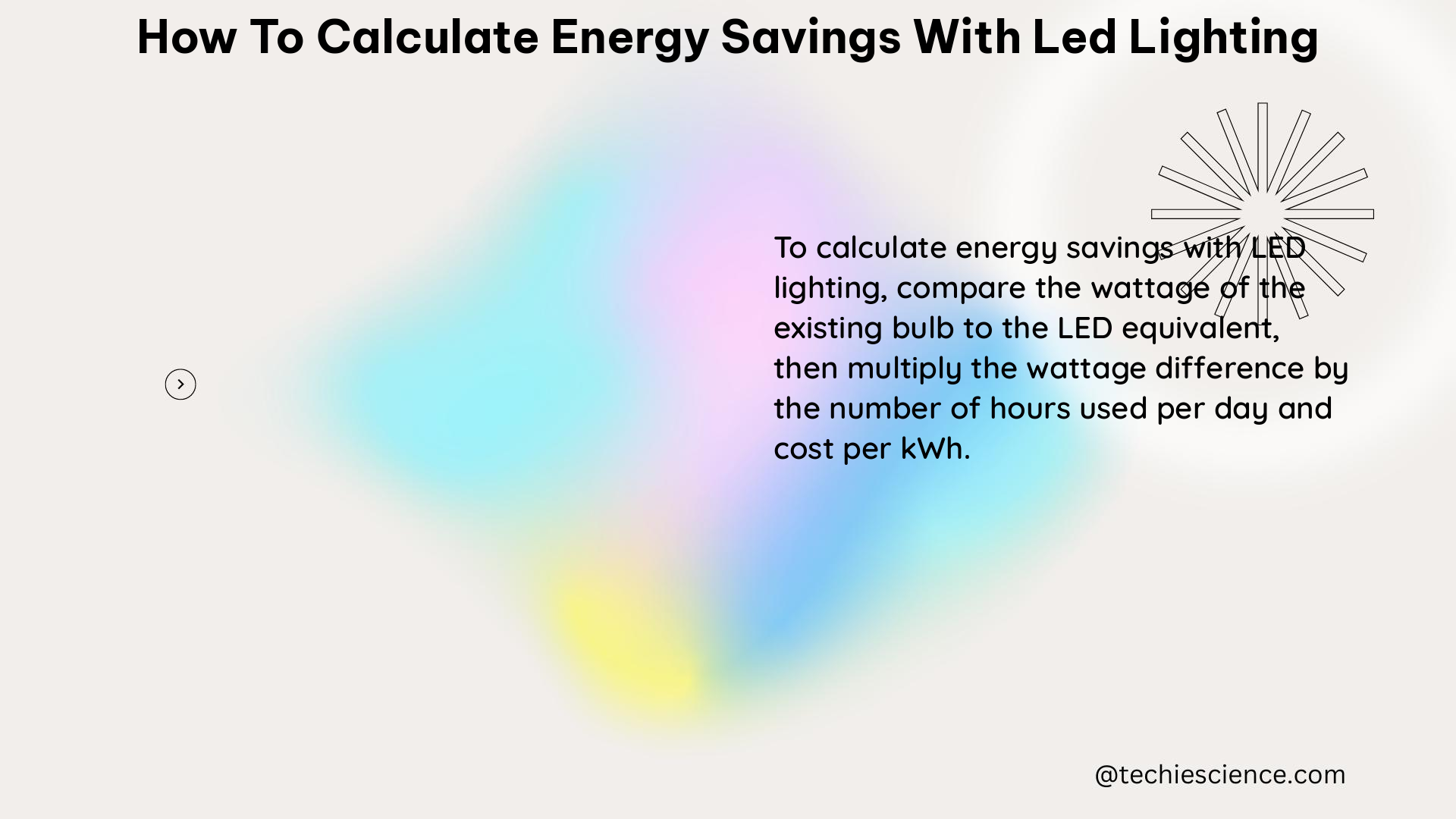Transitioning to LED lighting can significantly reduce energy consumption and lower your electricity bills. To maximize the benefits of this energy-efficient technology, it’s crucial to understand the step-by-step process of calculating the potential energy savings. This comprehensive guide will walk you through the calculations and provide you with the necessary tools to make informed decisions about your LED lighting upgrades.
Step 1: Gather the Necessary Information
To calculate the energy savings with LED lighting, you’ll need to gather the following data:
- Old Product Wattage: The wattage of the existing lighting product, such as a halogen bulb or a fluorescent tube.
- New Product Wattage: The wattage of the new LED lighting product you plan to install.
- Running Time: The number of hours the lights are on per day and the number of days per year.
- Electricity Rate: The cost of electricity per kilowatt-hour (kWh) in your local area, typically ranging from $0.10/kWh to $0.14/kWh.
Step 2: Calculate Energy Savings per Bulb

The energy savings per bulb can be calculated using the following formula:
Energy Savings per Bulb = Old Product Wattage - New Product Wattage
For example, if you’re replacing a 90-watt halogen bulb with a 14-watt LED bulb, the energy savings per bulb would be:
Energy Savings per Bulb = 90 watts - 14 watts = 76 watts
Step 3: Calculate Annual Running Time
To determine the annual running time, multiply the number of hours the lights are on per day by the number of days per year:
Annual Running Time = Hours per Day × Days per Year
For instance, if the lights are on for 12 hours per day and operated for 360 days per year, the annual running time would be:
Annual Running Time = 12 hours per day × 360 days per year = 4,320 hours per year
Step 4: Calculate Total Annual Energy Savings
The total annual energy savings can be calculated by multiplying the energy savings per bulb by the annual running time and dividing the result by 1,000 to convert it to kilowatt-hours (kWh):
Total Annual Energy Savings = (Energy Savings per Bulb × Annual Running Time) / 1,000
Continuing the example from the previous steps:
Total Annual Energy Savings = (76 watts × 4,320 hours per year) / 1,000 = 328 kWh saved per year
Step 5: Calculate Annual Dollar Savings
To determine the annual dollar savings, multiply the total annual energy savings by the electricity rate:
Annual Dollar Savings = Total Annual Energy Savings × Electricity Rate
Using the previous example with an electricity rate of $0.12/kWh:
Annual Dollar Savings = 328 kWh saved per year × $0.12/kWh = $39.36 saved per year per bulb
Additional Considerations
HVAC Savings
LED lighting generates less heat compared to traditional lighting, which can lead to additional savings on HVAC costs. The ASHRAE (American Society of Heating, Refrigerating and Air-Conditioning Engineers) rule of thumb states that it takes 30-35 watts of cooling to offset the heat generated for each 100 watts of lights within a space. To calculate the HVAC savings, you can use the following formula:
HVAC Savings = (Old Product Wattage - New Product Wattage) × 0.35 × Cooling Cost per Watt
The cooling cost per watt can be obtained from your HVAC system’s energy efficiency rating and the local electricity rate.
Maintenance Savings
LED lighting has a significantly longer lifespan compared to traditional lighting, reducing the need for frequent replacements and maintenance. This can result in additional cost savings over time, which should be factored into your overall LED lighting upgrade analysis.
Conclusion
By following the steps outlined in this comprehensive guide, you can accurately calculate the energy savings and potential cost savings associated with transitioning to LED lighting. This information will help you make informed decisions, maximize the benefits of LED technology, and contribute to your overall energy efficiency and sustainability goals.
References
- Energy Savings Measurement Guide by the Department of Resources, Energy and Tourism.
- How to Calculate Energy Savings for Lighting Only: A Step-by-Step Guide by Regency Supply.
- How to Calculate HVAC Energy Savings from an LED Lighting Retrofit Project by PKK Lighting.
- How LED Saves Energy: Calculation and Tips by LED Light Expert.
- Calculating Your Lighting Only Energy Saving In An LED Retrofit by Action Services Group.

The lambdageeks.com Core SME Team is a group of experienced subject matter experts from diverse scientific and technical fields including Physics, Chemistry, Technology,Electronics & Electrical Engineering, Automotive, Mechanical Engineering. Our team collaborates to create high-quality, well-researched articles on a wide range of science and technology topics for the lambdageeks.com website.
All Our Senior SME are having more than 7 Years of experience in the respective fields . They are either Working Industry Professionals or assocaited With different Universities. Refer Our Authors Page to get to know About our Core SMEs.